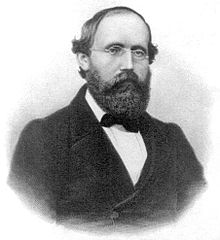Riemannian geometry
In differential geometry, Riemannian geometry is the study of differential manifolds (for example, a Riemannian manifold) with Riemannian metrics; that is to say, of an application that assigns a definite positive quadratic form to each point of the manifold in its tangent space, an application that varies smoothly from one point to another. This gives local ideas of (among other quantities) angle, length of curves, and volume. From these, other magnitudes can be obtained by integrating the local magnitudes.
It was first proposed in a general way by Bernhard Riemann in the 19th century. As particular special cases appear the two conventional types (elliptical geometry and hyperbolic geometry) of Non-Euclidean geometry, as well as Euclidean geometry itself. All of these geometries are treated on the same basis, as are a wide range of geometries with metric properties that vary from point to point.
Any differentiable manifold admits a Riemannian metric, and this additional structure often helps in solving differential topology problems. It also serves as an entry level for the more complicated structure of pseudo-Riemann manifolds, which (in the particular case of having dimension 4) are the main objects of the theory of general relativity.
There is no easy introduction to Riemannian geometry. The following articles can serve as an introduction:
- Metric tension
- Variety of Riemann
- Connection of Levi-Civita
- Healing
- Curve tensor.
Introduction
Riemannian geometry was first put forward in general by Bernhard Riemann in the 19th century. He deals with a wide range of geometries whose metric properties vary from point to point, including the standard types of non-Euclidean geometry.
Every smooth manifold admits a Riemann metric, which often helps to solve differential topology problems. It also serves as the entry level for the more complicated structure of the pseudo-Riemannian manifolds, which (in four dimensions) are the main objects of the theory of general relativity. Other generalizations of Riemannian geometry are Finsler geometry.
There is a close analogy of differential geometry with the mathematical structure of defects in regular crystals. Dislocations and disclinations produce torsions and curvatures.
The following articles provide some useful introductory material:
- Metric tension
- Variety of Riemann
- Connection of Levi-Civita
- Healing
- Riemann curvature tensor
- Riemann geometry glossary and metric
Classical theorems in Riemannian geometry
The following is a non-complete list of the most classical theorems of Riemannian geometry. The choice is made depending on its beauty, the importance and simplicity of the formulation.
General theorems
- Theorem of Gauss-Bonnet The integral of Gauss curvature in a 2-dimensional, compact Riemann variety is equal to 2π π χ χ (M){displaystyle 2pi chi (M)}Here. χ χ (M){displaystyle chi (M)} denotes the characteristic of Euler M.
- Nash immersion theorem also called Theorem Fundamental of Riemann Geometry. They indicate that each variety of Riemann can be isometrically submerged in an euclidian space Rn.
Big geometry
In all of the following theorems we assume some local behavior of space (usually formulated using the curvature assumption) to derive some information about the global structure of space, including some information about the topological type of the manifold or about the behavior of the points at "great enough" distances.
Pinch sectional curvature
- Theorem of the sphere. Yeah. M is a compact riemannian variety n- dimensional simply connected with a strictly narrow sectional curvature between 1/4 and 1, then M''' is diphenomorphous to a sphere.
- Cheeger's Theorem of Fineness. Given the constants C, D and V, there is only one finite number (up to dimorphism) of compact Riemannian n- Dimensional varieties with sectional curvatureK日本語 ≤ C, diameter ≤ D and volume ≥ V.
- Almost flat varieties of Gromov. There's a εn 0 such that if a n- The dimensional riemannian variety has a metric with a sectional curvature.Kأ م م م م م م م م م م م م م م م م م م م م م م م م م م م م م م م م م م م م م م م م م م م و م م م م م م م م و م م م م م م م م م م م م م م م م و و م م م م م م م م م م م و م م م م و و م م م م م م م م م م م م م م م و م م م م م م م م م م م م م م م و م م و م م مn and diameter ≤ 1, then its finite coverage is diphenomorphic to a null variety.
Sectional curvature limited below
- The Cheeger-Gromoll soul theorem. Yeah. M is a variety of Riemann n- non-compact, complete non-negative curved, then M contains a subvariant S compact, totally geodetic such that M it's diphenomorphic to the normal beam S (S It's called the soul of M .) In particular, if M has a strictly positive curvature everywhere, so it's dimorphic Rn. GRAM. Perelman in 1994 gave an astonishingly elegant/very demonstration of the conjecture of the soul: M It's diphenomorphic. Rn if it has a positive curvature in just one point
- Theorem of the Betti number of Gromov. There is a constant C = C(n) so if M It's a n' compact range of Riemann '-dimensional with positive section curvature, then the sum of its number of Bettis is as high as "C".
- Grove-Petersen's Theorem of Fineness. Given the constants C, D and V, there is only a finite number of compact riemannian homotopia types n- dimensional varieties with sectional curvature K ≥ C, diameter ≤ D and volume ≥ V.
Contenido relacionado
Sub-Object Classifier
Arthur Compton
Longitudinal wave


